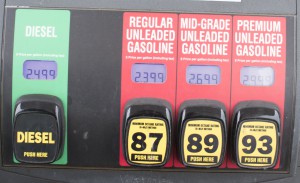With the summer driving season about to get underway, the price of gasoline is trending downward, following a small price spike in the late winter and early spring.
The national average is $2.34 per gallon, which is a penny cheaper than one week ago, seven cents less than a month ago, but 12 cents more than a year ago, according to the latest report from AAA.
The latest report by the Energy Information Administration, a unit of the U.S. Department of Energy, shows that gasoline demand increased by 252,000 barrels in the past week.
AAA, however, noted, “Despite the jump in demand, the continued oversupply of gasoline caused prices in most parts of the country to drop or remain steady with the exception of some states in the Great Lakes and Central regions, where prices increased by a penny or more.
(Excess diesel emissions killing 38,000 annually, report claims. Click Here for the story.)
In coming weeks, the onset of summer travel is likely to increase demand which might help dip into high gasoline stocks; however, it may not be enough demand to increase prices significantly, AAA concluded.
The biggest changes in gasoline prices were in Indiana where prices increased by 9 cents per gallon, Ohio and Michigan where prices increased 7 cents per gallon, and Kentucky where prices went up by a nickel. In Delaware and Florida the price of gasoline dropped by 5 cents per gallon and in South Carolina, Alabama, North Carolina and Pennsylvania where prices dropped 4 cents.
Not surprisingly, the most expensive gasoline was in Hawaii where gas was $3.06 per gallon, California where it was $2.98 per gallon and in Alaska where it was $2.90, Washington at $2.88, Oregon at $2.73 and Nevada $2.68.
Down time at the Valero Benicia refinery coupled with potential month-end work at Tesoro’s 166,000-barrels per day Martinez, California, refinery are creating supply concerns in the region. A drop in supply could potentially move prices higher in the coming weeks.
Around the Great Lakes where some of the largest prices swing have occurred in recent months despite high gasoline stocks in the regions, five states saw price increases on the week with Indiana, Ohio and Michigan, leading the way.
(Click Here for a look at the next-gem Mercedes GLA.)
Meanwhile every state in the South and Southeast saw prices for gasoline decline for the week, with the exception of Kentucky. Consumers can find the cheapest gas in the country in this region, with eight states landing on the top 10 weekly list of least expensive markets, including South Carolina, Oklahoma, Alabama, Mississippi, Tennessee, Arkansas, Louisiana and Missouri.
Early this week U.S. petroleum futures were trading just below $50 per barrel. Prices rallied after officials from Russia and Saudi Arabia announced that they plan to extend production cuts into March 2018.
The news followed the release of the Organization of Petroleum Exporting Countries’ May report, which warns that the global oil market will not rebalance by the end of the year unless there is a collective effort from all oil producers to increase market stability.
OPEC is expected to draft a formalized production cut extension during its meeting in Vienna, Austria, on May 25, and Wall Street hailed an apparent bi-lateral agreement to reduce production by two of the world’s largest producers, Russia and Saudi Arabia.
(To see more about Ford cutting 1,400 jobs, Click Here.)
The expected result of OPEC’s actions is far from certain. Until it is, drivers may continue to benefit at the pump – even during the typically more expensive summer driving season, AAA noted. Last week, however, U.S. drillers added an additional nine oilrigs, bringing the total U.S rig count to 712 and marking 17 consecutive weeks of growth.

